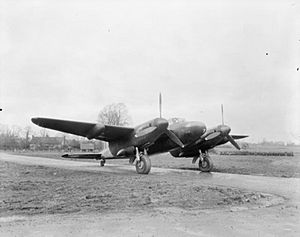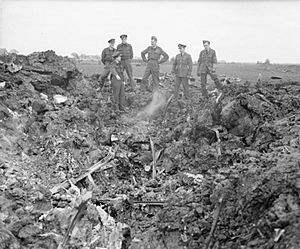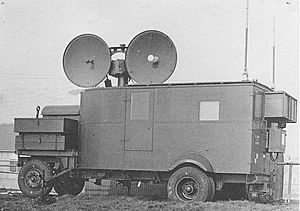Operation Steinbock facts for kids
Quick facts for kids Operation Steinbock |
|||||||
|---|---|---|---|---|---|---|---|
| Part of World War II | |||||||
|
Air Marshal Sir Roderic Hill inspects the wreckage of a Junkers Ju 188 E-1 belonging to 2. Staffel Kampfgeschwader 6 (Bomber Wing 6) which crashed in Shopland, Essex, 21 March 1944. |
|||||||
|
|||||||
| Belligerents | |||||||
| Commanders and leaders | |||||||
| Roderic Hill Frederick Alfred Pile |
Dietrich Peltz Hugo Sperrle |
||||||
| Strength | |||||||
| ~ 25 squadrons | 524 bombers | ||||||
| Casualties and losses | |||||||
|
Aircraft 1 destroyed in combat 1,556 civilians killed |
Aircraft 329 destroyed |
||||||
Operation Steinbock (which means Operation Capricorn in German) was a series of air attacks by the German Air Force (called the Luftwaffe) during World War II. It was also known as the Baby Blitz. These attacks targeted southern England, especially London, from January to May 1944. It was the last major bombing campaign by German planes against Britain during the war.
By late 1943, Allied forces were heavily bombing German cities and factories. In response, Adolf Hitler ordered the Luftwaffe to bomb the United Kingdom. This was meant to get revenge and also to boost morale for the German people. The attacks happened at the same time as the British Royal Air Force (RAF) was bombing Berlin.
The Luftwaffe gathered about 474 bomber planes for these attacks. Most of the targets were in and around London. In Britain, people called it the Baby Blitz because it was much smaller than the earlier, more intense bombing campaign known as The Blitz (1940–1941).
Operation Steinbock started in January and ended in May 1944. It didn't achieve much for Germany. The German forces lost about 329 planes during these five months. This meant about 70% of the planes used were destroyed.
Later, these revenge attacks changed into attempts to stop the Allies from invading France. However, Operation Steinbock had weakened the Luftwaffe so much that it couldn't fight back effectively when the D-Day invasion began on June 6, 1944. This was the last big bombing campaign against England using regular planes. After this, Germany mainly used V-1 flying bombs and V-2 rockets to attack British cities.
Contents
Why it Happened: The Background
By the end of 1943, the Allies were bombing Germany very heavily. The German air defenses, especially their night fighters, tried to stop the British RAF Bomber Command. They caused many losses for the RAF, but they couldn't stop the widespread destruction of German industrial cities.
How Steinbock Started
The leader of the Luftwaffe, Hermann Göring, wasn't very good at understanding air warfare. He often interfered with air defense plans. After major bombings like the one on Hamburg, which caused many deaths and destroyed large parts of the city, Hitler became more involved in Luftwaffe decisions.
Göring believed that bombing British cities would make the German people feel better, even if their own cities were being destroyed. He said, "All they [the German people] wish to hear when a hospital or a children's home in Germany is destroyed is that we have destroyed the same in England!"
German air force leaders wanted to focus on defending Germany by building more fighter planes. But Hitler and Göring still believed the Luftwaffe should be an attacking force. Göring eventually decided that the only way to stop the Allied bombings was to bomb the enemy back very hard. He put Generalmajor Dietrich Peltz in charge of this new large-scale bombing operation against Britain, especially London.
The goal of Unternehmen Steinbock (Operation Capricorn) was to "avenge terror attacks of the enemy." Germany hoped to start the operation in December 1943, but it wasn't ready until January 1944. They gathered nearly 600 planes by moving bomber units from other battle areas.
German Air Force Planes and Tactics
Three years after the first Blitz, the Luftwaffe still used many older bomber planes like the Junkers Ju 88. They also had newer versions like the Junkers Ju 188 and the Dornier Do 217. The Heinkel He 177A was their only true heavy bomber, but it had engine problems.
The Ju 88 and Do 217 carried most of the bombs. These planes had some defensive guns, but their design meant that if a night fighter hit the cockpit, most of the crew could be killed. Allied bombers like the B-17 Flying Fortress spread their crews out, giving them a better chance to survive.
German bombers used new radar systems like FuG 216 Neptun to detect approaching British night fighters. They also used Kettenhund radar jammers and Düppel (chaff), which were strips of tin foil. Düppel confused British ground radar, making it hard to tell the height, direction, and speed of the bombers.
The Luftwaffe also used faster planes like the Messerschmitt Me 410 Hornisse and Focke-Wulf Fw 190 fighter-bombers. These planes were hard to intercept because of their speed, but they couldn't carry as many bombs as the larger bombers.

How German Bombers Attacked
In 1940, German bombers flew individually. But in 1944, they used a "bomber stream" tactic, similar to the British. Planes flew together in a loose formation. They would cross the English Channel or North Sea at a low height, then climb to their bombing altitude. After dropping their bombs, they would dive to a lower height to escape.
German crews had navigation aids like Knickebein, X-Verfahren, and Y-Verfahren. These systems used radio beams to guide the planes and even release bombs automatically. A special pathfinder unit, I./KG 66, used captured British GEE sets (which they called Hyperbel Gerät) to help with navigation.
Another system called Egon was similar to the British Oboe system. It used ground radar stations to track planes and send instructions to the crew, telling them when to release their bombs.
Once near the target, pathfinder planes would mark the area with incendiary bombs or flares. This helped the main bomber force know where to drop their bombs.
The bombs used in Steinbock included:
- SC (Sprengbombe Cylindrisch): General-purpose bombs that caused maximum damage on the surface.
- SD (Sprengbombe Dickwandig): Bombs with some power to penetrate armor.
- PC (Panzerbombe Cylindrisch): Fully armor-piercing bombs.
- Incendiaries: Bombs designed to start fires.
- Sea-mines: Dropped by parachute, but not very accurate.
- SD2 (Sprengbombe Dickwandig 2): Small cluster bombs that were very effective against people.
- Aerial mines/parachute mines: Large explosives (500 to 1,000 kg) that didn't penetrate the ground but exploded to destroy buildings in a wide area.
For Steinbock, the Germans mainly used heavy bombs. The largest was the SC1800, weighing about 1,800 kg (nearly 4,000 pounds). Some SC2500 bombs (about 2,500 kg) were also used by the He 177A-3s.
The Egon system was a way for ground controllers to guide bombers. It used special radio signals from the plane (called an IFF transponder) picked up by two Freya radar stations on the ground.
Here's how it worked: 1. Tracking: The first Freya station would track the bomber's path. 2. Guidance: Ground operators would see the plane's position on a map and send instructions (like "change direction" or "open bomb doors") to the crew using Morse code or radio. 3. Bombing: The second Freya station would tell the crew exactly when to release their bombs when they were over the target.
This system was meant to help with accuracy, especially for the pathfinder planes.
British Defenses Ready for Action
The British RAF knew about the upcoming German attacks thanks to secret intelligence called Ultra. They learned that Germany was building a large bomber fleet for an attack.
In late 1943, the RAF reorganized its defenses. RAF Fighter Command, led by Air Marshal Sir Roderic Hill, was in charge of night fighter operations in southern England.
Fighter Command had 16 squadrons of de Havilland Mosquito and Bristol Beaufighter night fighters. These planes were fast, well-armed, and equipped with special Airborne Interception (AI) radar. Newer AI Mk. X radar was especially good at detecting targets at low altitudes.
Anti-Aircraft Command, led by General Frederick Alfred Pile, was responsible for ground defenses. They had over 2,700 anti-aircraft guns around London. Many of these guns had new radar systems (GL Mk. III) that made their night firing very accurate, even in bad weather.
British Night Fighter Tactics
British night fighters, like the Mosquito and Beaufighter, would approach German bombers from behind and slightly below. This made them harder to see and helped them avoid the bomber's turbulent air. Pilots would get close, match the bomber's speed, then fire their guns so the enemy plane would fly into the gunfire.
Night fighter pilots worked with ground control and searchlights. Ground-controlled interception (GCI) radar would guide the night fighter to within a mile of the bomber. Then, the fighter crew would use their own AI radar to complete the interception. Sometimes, searchlights would converge on a German plane to help the night fighter spot it.

The Operation: Attacks and Outcomes
January Attacks
The Luftwaffe started its attacks on January 2/3, 1944, even before Steinbock officially began. Fast Me 410s and Fw 190s flew over Kent, Sussex, and London. They killed one person, but four Fw 190s were shot down by British Mosquitos.
On January 21/22, the first major attack on London happened. The British had just heavily bombed Berlin, so the Germans called their targets in London by names of German cities to show it was revenge. About 230 German planes took off, carrying 500 tons of bombs.
However, German navigation was poor. Only about 15 bombers actually hit London. Most bombs were scattered across the surrounding areas. The Luftwaffe lost 18 bombers that night, with many falling to British Mosquitos and anti-aircraft fire.
A second wave of 200 bombers was sent later that night, but bad weather and British jamming made it even harder. Only 25 planes hit London. The Germans lost another 18 bombers. Overall, the damage was small: 74 civilians were killed, and a few factories were lightly damaged.
Hitler was very angry that the Luftwaffe couldn't find London, which was relatively close, while the British were bombing German cities from far away. German commanders blamed poor navigation aids and inexperienced crews.
February Attacks
On February 3/4, the Luftwaffe attacked again. German propaganda claimed great success, but British reports showed the bombs were scattered widely, hitting areas as far as Gloucestershire. Only 25 of the 190 tons of bombs fell on London. 17 people were killed there.
The Luftwaffe lost 15 bombers, mostly over the sea. German commanders were worried about these losses.
On February 13/14, another large attack was planned with 230 German planes. Peltz, the German commander, tried to boost morale by downplaying the threat of British night fighters. However, many German planes had to turn back due to engine problems, especially the He 177s.
Again, only 15 of the scattered bombers hit London. Other towns like Clacton-on-Sea were badly damaged. The Luftwaffe lost 10 bombers, with some falling to British Mosquitos and ground fire. German pilots noticed the increased anti-aircraft fire over London, which might have made inexperienced crews drop their bombs too early.
The most damaging attack of Steinbock happened on February 18/19. About 184 German bombers reached London and bombed accurately. They caused 480 fires, killed 179 civilians, and seriously injured 484. Areas like Willesden and Kensington were badly hit. A bridge at Goldhawk Road tube station was destroyed, stopping London Underground trains. The Luftwaffe lost nine aircraft, with some shot down by Canadian Mosquito squadrons.
On February 20/21, another 165 German planes attacked London. They used a new tactic, dropping flares in a simple pattern to mark the target. This attack started over 600 fires and killed 216 people, mostly in Fulham, Putney, and Chiswick. The Great Western Hotel was severely damaged, and bombs hit government buildings near 10 Downing Street. Nine German bombers were lost.
Attacks continued until February 24/25. On February 22/23, 185 German bombers attacked London, causing 230 fires and 29 casualties. On February 23/24, 130 planes targeted the Isle of Dogs docks. Colchester was hit badly by 1,400 incendiaries, but only one person was hurt. Five German bombers were lost.
On February 24/25, 170 German planes targeted the Westminster area, including government buildings. Most of the 100 tons of bombs fell on London, starting 250 fires and killing 75 people. The Mosquitos of Fighter Command were very effective, shooting down nine German bombers.
March Attacks
By March 2/3, the German bomber groups were struggling to get planes ready. Only about 70 planes attacked England. They targeted Victoria Station. Despite the smaller force, they caused significant damage: 900 houses were damaged, and 500 people lost their homes. The Luftwaffe lost eight aircraft.
On March 14/15, the Germans tried a new tactic, sending Fw 190s to bomb Plymouth as a diversion, hoping to draw away British defenses from London. However, the diversion failed, and the main bomber force was detected over London. Bombs fell on Belgravia, and Muriel Wright, the girlfriend of future novelist Ian Fleming, was killed. 19 German aircraft were lost.
Peltz then decided to attack Hull on March 19/20. This port city was important but far away, requiring a long flight over the North Sea. Despite 131 bombers being sent, most bombs fell in rural areas far from Hull. The city itself had no damage or casualties. Nine German bombers were lost, with two shot down by British Mosquitos.
On March 21/22, the Luftwaffe returned to London. The attacks were spread out, hitting areas from Hammersmith to Croydon. 247 fires were recorded, and 61 civilians were killed. Paddington Station was severely damaged. The Luftwaffe lost 10 bombers.
On March 24/25, 143 German planes attacked London again, targeting Whitehall. They caused 20 deaths, mostly in Croydon. The historic St Dunstan-in-the-West church was damaged. 17 German aircraft were lost.
On March 27/28, the Luftwaffe targeted Bristol, hoping to disrupt Allied preparations for the invasion of France. Despite 139 bombers being sent, not a single bomb landed on the city. Most bombs fell across Somerset. The Germans lost 14 aircraft.
April Attacks
German attacks slowed down in early April. On April 18/19, the Luftwaffe tried to attack London again. Only 53 of 125 planes crossed the English coast, and 17 German bombers were lost.
On April 23/24, Bristol was targeted again, but the raid failed just like the first time. Most bombs fell near Poole or Bournemouth. 13 German aircraft were lost.
By April 1944, the Allies were preparing for Operation Overlord (the D-Day invasion). German reconnaissance planes tried to observe Allied preparations but failed. The Luftwaffe then tried four consecutive night raids on Portsmouth starting April 25/26, but these also failed.
On April 29/30, the Luftwaffe aimed to attack a British battleship in Plymouth harbour. They used special Fritz X guided bombs. However, heavy mist and the failure of German pathfinders meant the attack was unsuccessful. 27 civilians were killed. The Germans lost their group commander, Hauptmann Herbert Pfeffer, who was shot down by a Canadian Mosquito.
May Attacks
By May, Operation Steinbock was mostly over. The number of German bombers and targets had greatly decreased. From May 3 to 12, there were only a few small attacks, causing very little damage. The Germans lost five aircraft.
On May 14/15, the Germans tried one last major attack on Bristol, hoping to finally hit it. They gathered 150 aircraft and focused on high explosives instead of incendiaries. However, Bristol once again escaped major damage. Only a third of the planes were tracked by British radar, and most crews failed to find the target. Eleven German bombers were lost.
What Happened Next
Even though the 'Baby Blitz' involved more German planes than any other raids since 1941, it didn't cause much damage or many casualties. This was because British air and ground defenses were very effective, German bomber crews were often inexperienced, and Germany simply didn't have enough bombers.
Most bombs missed their targets, and the damage caused was tiny compared to what the Allies were doing to Germany. The fact that Germany didn't target the areas where the Allies were preparing for D-Day meant that Operation Overlord was not delayed at all.
Ironically, these raids hurt Germany more than Britain. The Luftwaffe lost many irreplaceable aircrew and modern aircraft. This weakened their ability to fight back when the D-Day invasion began. After this failure, the Nazi leaders looked for new, unconventional ways to attack Britain, which led to the V-1 flying bomb and V-2 rocket campaigns later that year.
German losses:
- 270 Junkers Ju 88s
- 121 Dornier Do 217s
- 35 Junkers Ju 188s
- 46 Heinkel He 177As
- 27 Messerschmitt Me 410s
- 25 Focke-Wulf Fw 190s
British losses:
- 7 to unknown causes
- 1 destroyed by enemy action
- 5 damaged by enemy action
- 1 destroyed by friendly fire
- 14 lost on intruder operations January–May 1944
Civilian casualties:
- 1,556 killed
Images for kids
-
Pall Mall, London after a Steinbock raid February 1944
-
Pilot Officer J Allen (right) and Flight Sergeant W Patterson, 96 Squadron, survey the wreckage of a Ju 88A-4. It belonged to 6. Staffel of KG 6. The machine was code 3E+BP Werknummer 2537. Unteroffizier Helmut Barbauer and Friedrich Schork were taken prisoner. Hugo Muhlbauer and Fritz Gotze were killed.










